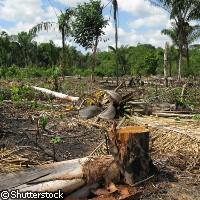Amazon deforestation booms but then busts
Does the deforestation of the Brazilian Amazon rainforest increase the well-being of people living in the region? New international research shows that while it flourishes at first, a decline follows; this pattern is called 'boom and bust'. Funded in part by the EU's Sixth Framework Programme (FP6), the study indicates that the pre- and post-frontier levels of human development are similarly low. Diverse groups of people such as investors and miners look for new opportunities in the Brazilian Amazon. But it is mostly people who are down on their luck that turn to the region for a better quality of life. Forest conversion for economic development involves removing trees for agriculture, cattle ranching and logging. A total of 155,000 square kilometres of rainforest in the Brazilian Amazon has been cut in the past decade. The researchers say forest clearance rates have averaged over 1.8 million hectares per year, and the deforestation frontier is moving forward very quickly. Led by Ana Rodrigues of the Center for Evolutionary and Functional Ecology at the National Centre for Scientific Research (CNRS) in France, the research team used the Human Development Index designed by the United Nations Development Program (UNDP) that averages living standard, literacy and life expectancy to assess 286 municipalities surrounding the rainforest that are in various stages of development. The researchers measured changes over periods of space, not periods of time, according to Dr Rodrigues. 'Our analysis investigated relative development patterns across space, rather than the trajectory of absolute development through time,' the study reads. 'The latter was not possible given a lack of long-term time-series data, but the former has the advantage of standardising for temporal changes that affect the entire region (e.g. economic cycles in the Brazilian economy).' They compared different parameters of human well-being (e.g. income, education, life expectancy) across the Brazilian Amazon in 'regions that are ahead of deforestation frontiers, regions that are in the middle, and regions that are already post-frontier'. The initial increase in well-being they observed is likely due to how the locals capitalise on newly available natural resources, like land for pasture; the team also believes that the higher incomes and new roads generate better living conditions. 'The Amazon is globally recognised for its unparalleled natural value, but it is also a very poor region. It is generally assumed that replacing the forest with crops and pastureland is the best approach for fulfilling the region's legitimate aspirations to development,' explained Dr Rodrigues in a Science podcast interview. 'This study tested that assumption. We found [that] although the deforestation frontier does bring initial improvements in income, life expectancy, and literacy, such gains are not sustained,' she added. 'We suggest that there should be a better model of development for the region; a challenge where one can improve human well-being, which is sustained but without depleting the region's natural resources,' said Dr Rodrigues. 'We think the 'boom and bust' pattern is reflecting the overexploitation and then the exhaustion of the natural resources including timber, land quality, soil fertility.' A better model would not lead to the long-term exhaustion of natural resources, according to the lead investigator. 'We believe that conditions are now starting to be created for such a model where the forest is actually valued more alive than felled; it is through the process of ongoing negotiations, for example, which are starting to value the forest for its carbon storage capacity, and compensating countries for non-deforesting by not having carbon emissions from deforestation,' she said. In general, widespread deforestation began when Europeans began emigrating to the region, and with the Portuguese colonisation in the 1500s, she commented. 'The large-scale deforestation in the Amazon is relatively recent; most of the deforestation having taken place in the past few decades,' she told Science. Professor Andrew Balmford of Conservation Science at the University of Cambridge in the UK commented: 'The current boom-and-bust trajectory of Amazonian development is therefore undesirable in human terms as well as potentially disastrous for other species, and for the world's climate. Reversing this pattern will hinge on capturing the values of intact forests to people outside the Amazon so that local people's livelihoods are better when the forest is left standing than when it is cleared.'
Countries
France, United Kingdom



